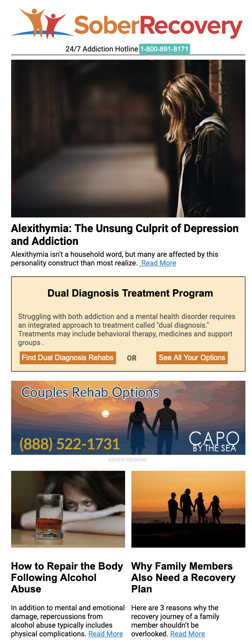Drug Rehab Center for Youths Los Banos CA
(209) 381-6800
Services Provided
Substance abuse
Types of Care
Outpatient
Special Programs/Groups
Adolescents, Women, Men, Criminal justice clients
Language Services
ASL or other assistance for hearing impaired, Spanish

(916) 974-8090
Services Provided
Substance abuse , Detoxification, Methadone Maintenance, Methadone Detoxification, Buprenorphine Services
Types of Care
Outpatient
Special Programs/Groups
Persons with co-occurring mental and substance abuse disorders, Women
Language Services
Chinese, Russian, Spanish

Los Angeles, CA
Substance abuse
Types of Care
Outpatient
Special Programs/Groups
Adolescents, Persons with co-occurring mental and substance abuse disorders

Substance abuse , Detoxification, Buprenorphine Services
Types of Care
Hospital inpatient, Outpatient, Partial hospitalization/day treatment
Special Programs/Groups
Adolescents, Persons with co-occurring mental and substance abuse disorders, Seniors/older adults

Substance abuse
Types of Care
Outpatient
Special Programs/Groups
Adolescents, Persons with HIV/AIDS, Criminal justice clients
Language Services
Spanish

Eating Disorders in Relation to Depression Corcoran CA
(559) 733-6877
Services Provided
Substance abuse , Detoxification, Methadone Maintenance, Methadone Detoxification, Buprenorphine Services
Types of Care
Outpatient
Special Programs/Groups
Pregnant/postpartum women
Data Provided by:

Substance abuse
Types of Care
Outpatient
Language Services
Spanish
Data Provided by:

Substance abuse , Detoxification
Types of Care
Residential short-term treatment (30 days or less), Residential long-term treatment (more than 30 days)
Special Programs/Groups
Women, Residential beds for clients' children
Language Services
Spanish
Data Provided by:

559-584-8100
Services Provided
Adolescent Outpatient Substance Abuse Treatment
Types of Care
Outpatient substance abuse treatment
Language Services
English/Spanish
(714) 821-5311
Services Provided
Substance abuse , Detoxification, Methadone Maintenance, Methadone Detoxification
Types of Care
Outpatient
Special Programs/Groups
Persons with HIV/AIDS, Pregnant/postpartum women
Language Services
Arabic, Spanish
Data Provided by:

Substance abuse
Types of Care
Outpatient
Special Programs/Groups
Adolescents, Persons with co-occurring mental and substance abuse disorders, DUI/DWI offenders, Criminal justice clients
Language Services
ASL or other assistance for hearing impaired, Spanish
Data Provided by:

Substance abuse
Types of Care
Outpatient
Special Programs/Groups
DUI/DWI offenders, Criminal justice clients
Language Services
Spanish
Data Provided by:

Hanford, CA
Substance abuse
Types of Care
Outpatient
Special Programs/Groups
Adolescents, Pregnant/postpartum women, Women, Men, Criminal justice clients
Language Services
Chinese, Spanish
Data Provided by:

(951) 676-8241
Services Provided
Substance abuse , Detoxification, Buprenorphine Services
Types of Care
Outpatient, Partial hospitalization/day treatment
Special Programs/Groups
Adolescents, Persons with co-occurring mental and substance abuse disorders, Persons with HIV/AIDS, Women
Data Provided by:

Substance abuse
Types of Care
Outpatient
Special Programs/Groups
Adolescents, Persons with HIV/AIDS, Criminal justice clients
Language Services
Spanish
Data Provided by:


Eating Disorders in Relation to Depression
There are increased chances of developing a depressive disorder if the eating disorder goes untreated for a longer period, and however at the same time, depression and other mental health problems are also known to add to the danger of developing an eating disorder. The fact is there is a relationship between depression and eating disorders and other mental health problems can coexist with both. Both depression and eating disorders are becoming increasingly common. According to the Mental Health Foundation 10% of the population in the UK will experience some form of depression every year, and 2% of women as well as some men will suffer from an eating disorder. Anorexia is more likely to affect young women whereas bulimia is more likely to affect older women and is more common than anorexia. Compulsive eating affects both women and men equally and approximately 10% of all people with eating disorders are men.What is a depressive disorder?
A depressive disorder can be defined as a set of symptoms ranging from mild to severe that coexist with overwhelming feelings of sadness and an inability to take pleasure in activities that were once enjoyed to the extent that they interfere with normal daily routines. There are several different types of depressive disorders including clinical depression, bipolar disorder or manic depression, post natal depression, seasonal affective disorder or SAD and post traumatic stress disorder. No one knows why some people become depressed and not ...
Click here to read the rest of this article from Sober Recovery




